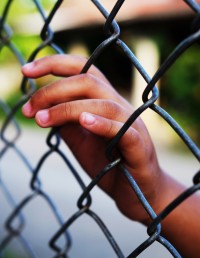NCYL LIVE — 'Freedom to Learn': Panelists discuss challenges to educating youth detention facilities
Experts explore issues plaguing oft-overlooked programs, paths to solutions
Sometimes lost in the ever-expanding — and critically important — movements to reform our juvenile justice and education systems is the space in which the two intersect: Schools within detention centers.
To help shine a light on this critical area, which is often overlooked both by civic leaders and members of the public, the National Center for Youth Law hosted “Freedom to Learn: Education Reform as Part of the Youth Decarceration Movement,” an expansive conversation with experts in the field of education within incarceration settings. Check it out here.
The 43-minute forum featured Tayo Belle, an attorney with the School Justice Project; Kate Burdick, an attorney with the Juvenile Law Center; and Oswaldo Lira, a youth advocate with the Arts for Healing and Justice Network. It was moderated by Stephanie Horwitz, an Equal Justice Works Fellow with the National Center for Youth Law. Horwitz's Equal Justice Works Fellowship is sponsored by Morrison and Foerster.
Improper staffing, a lack of teacher motivation, inadequate resourcing, a dearth of follow-up supports, and widespread disconnect between schools in detention centers and the traditional school districts that surround them were among the issues explored by the panelists.
“[Some teachers] just see them as a mistake to society,” Lira said of students who are incarcerated, a group to which he once belonged. “They did whatever they did to get in here, but that doesn’t mean they should have less education because of where they’re at.”
Staff and resources
Each of the panelists pointed to issues involving staffing and a general lack of resources provided to education programs within detention centers.
Staffing shortages have affected programs across the country, Burdick said. Compounding that issue, she and Lira both pointed out, is that many teachers within these programs are unqualified, unmotivated, or both.
“This is a situation where we need to be having teachers who make a connection and actually want to be there,” Burdick said. “When there are teachers who are passionate about working with young people in confinement settings, there is real progress that can happen. Everyone who has gone to school knows that having a teacher that you feel strongly about can make the difference or not in how connected you feel to your education and whether you want to show up to school every day. Having that be the case in all settings is really important.”
Belle noted that apathy among staff in these detention settings can have far-reaching impacts. An example of this, she said, can be seen in the growing digital gap. Although traditional schools have made major strides during the pandemic in improving access to technology for students, schools within detention centers have gone the opposite direction, with technology gaps widening. This is due in part, Belle said, to staffers in many cases feeling that students aren’t worth extra effort.
“There’s nothing more heartbreaking for me than to see that level of apathy occur where the government folks who are responsible for providing this education just aren’t taking that extra step,” she said.
Follow-up supports
Each of the panelists also agreed that more focus needs to be placed on helping students as they transition out of detention and back into communities. This includes ensuring that credits can transfer to traditional schools and that life-skills are included in curriculum.
Lira said he thought he was on track to graduate with his class when he left detention, but learned soon after that his credits were not aligned and that he was actually a year behind.
“That was a little bummer because I couldn’t graduate with my class I was supposed to,” he said.
Belle said she’d love to see more done to help students post-incarceration.
“All these young kids, all these older kids, they’re coming right back to our communities, so investing in them is so critical,” she said. “It’s a major piece of the puzzle, and until we get that piece together, it’s not going to be the type of comprehensive reformation that we’re hoping to see.”
More
During the discussion, the panelists also explored how education in incarceration settings can align with the decarceration movement, the structural barriers that prevent youth in these settings from reaching their goals, and how community schools can help improve these settings.
“This is an issue that shouldn’t be overlooked because for as long as young people continue to be incarcerated, there will need to be educational programs within incarcerated settings,” said Horwitz, the moderator. “And often, education programming makes up a core part of the overall experience of a young person who’s incarcerated.”





